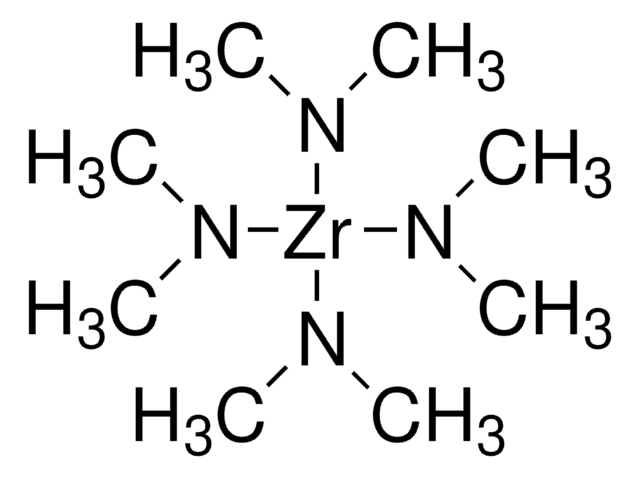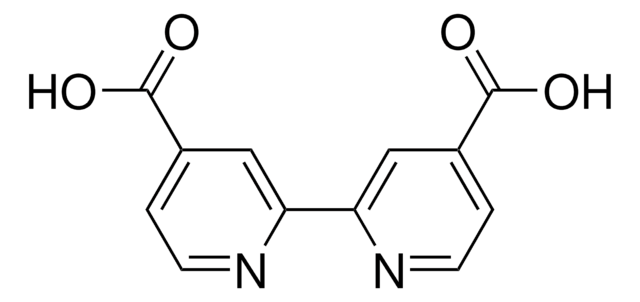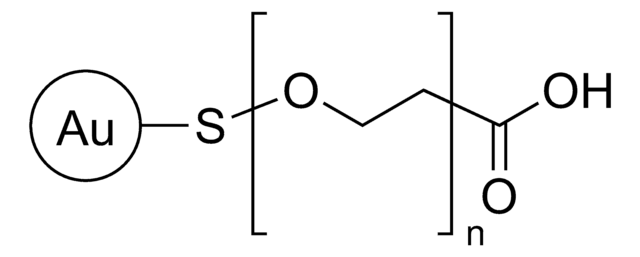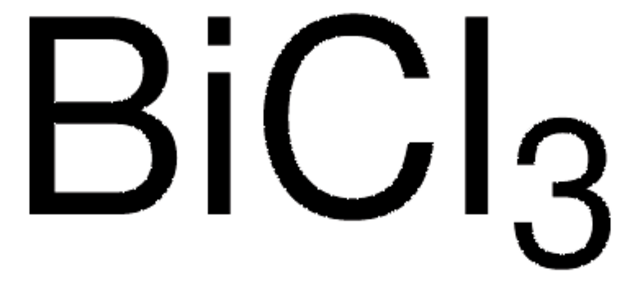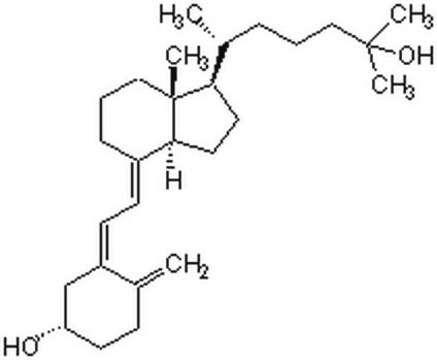추천 제품
일반 설명
Gold nanoparticles (AuNPs) ranging from 2-200nm in diameter find applications in diverse fields. They show excellent biocompatibility and attractive physicochemical properties. Poly (ethylene) glycol (PEG) surface coatings on gold nanoparticles help in the reduction of protein adsorption, reduce nonspecific interactions with cells and greatly improve the pharmokinetics of these nanoparticles and reduce aggregation of the nanoparticles. PEG layer density depends inversely on the AuNP curvature. Denser coating was possible on smaller AuNPs. Carboxylic acid functionalized GNPs form conjugates with various protein molecules due to the electrostatic attraction between the negatively charged carboxylate groups and positively charged amino groups of protein. Since it adheres to cell membranes, it may find use in cellular and intracellular targeting in targeted drug delivery applications and also used in biodistribution studies.
애플리케이션
Several other specific applications have been listed below:
- Since they adhere to cell membranes, AuNPs may find use in cellular and intracellular targeting in targeted drug delivery applications and may also be used in biodistribution studies.
- AuNPs may also be used in photothermal therapy and radiotherapy.
- AuNPs ranging from 10 to 250 nm, were studied to have been absorbed primarily by liver and spleen, when injected intravenously in rats.Whereas, 10 nm nanoparticles were distributed more broadly into various organs.
- Carboxylic acid end-groups bind with various proteins and hence are used in targeted drug delivery and gene therapy.
Functionalized Particles have been extensively used to study cellular uptake of nanoparticles and targeted drug delivery.
Storage Class Code
12 - Non Combustible Liquids
WGK
WGK 1
Flash Point (°F)
Not applicable
Flash Point (°C)
Not applicable
가장 최신 버전 중 하나를 선택하세요:
Alexandre Albanese et al.
ACS nano, 5(7), 5478-5489 (2011-06-23)
Aggregation appears to be a ubiquitous phenomenon among all nanoparticles and its influence in mediating cellular uptake and interactions remain unclear. Here we developed a simple technique to produce transferrin-coated gold nanoparticle aggregates of different sizes and characterized their uptake
Nishima Wangoo et al.
Journal of colloid and interface science, 323(2), 247-254 (2008-05-20)
We report a novel strategy for the synthesis of aqueous stable, carboxylated gold nanoparticles (GNPs) by using glutamic acid as the reducing agent. The ratio of chloroaurate ions, AuCl(-)(4) to glutamic acid was optimized in the reaction medium to obtain
Gold nanoparticles for the improved anticancer drug delivery of the active component of oxaliplatin.
Sarah D Brown et al.
Journal of the American Chemical Society, 132(13), 4678-4684 (2010-03-17)
The platinum-based anticancer drugs cisplatin, carboplatin, and oxaliplatin are an important component of chemotherapy but are limited by severe dose-limiting side effects and the ability of tumors to develop resistance rapidly. These drugs can be improved through the use of
Xiao-Dong Zhang et al.
International journal of nanomedicine, 6, 2071-2081 (2011-10-07)
Gold nanoparticle toxicity research is currently leading towards the in vivo experiment. Most toxicology data show that the surface chemistry and physical dimensions of gold nanoparticles play an important role in toxicity. Here, we present the in vivo toxicity of
Timothy A Larson et al.
ACS nano, 6(10), 9182-9190 (2012-09-27)
Polyethylene glycol (PEG) surface coatings are widely used to render stealth properties to nanoparticles in biological applications. There is abundant literature on the benefits of PEG coatings and their ability to reduce protein adsorption, to diminish nonspecific interactions with cells
문서
The recent emergence of a number of highly functional nanomaterials has enabled new approaches to the understanding, diagnosis, and treatment of cancer.
Biomaterials science involves the design and fabrication of smart materials for studying, directing, or mimicking biology. For successful integration of biomaterials in biological research, a meaningful understanding of biological systems is required.
자사의 과학자팀은 생명 과학, 재료 과학, 화학 합성, 크로마토그래피, 분석 및 기타 많은 영역을 포함한 모든 과학 분야에 경험이 있습니다..
고객지원팀으로 연락바랍니다.

